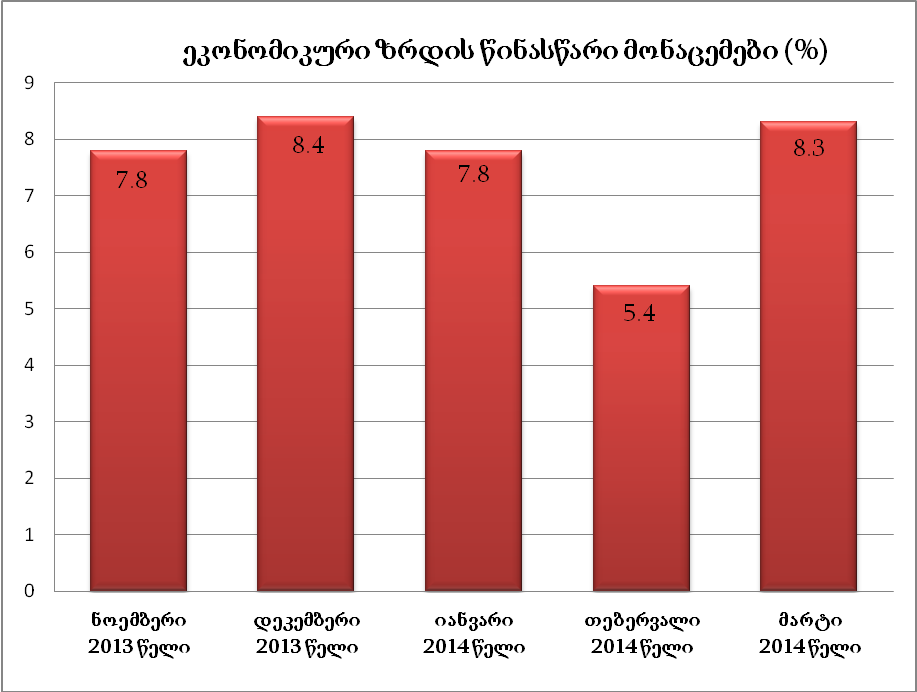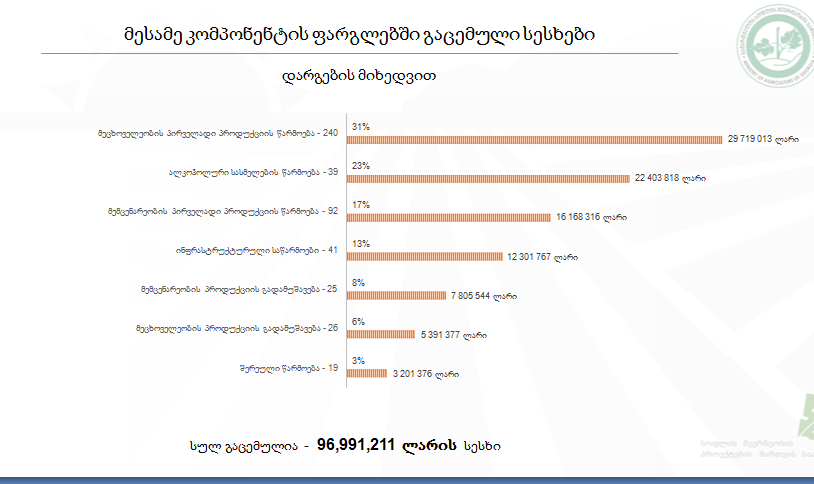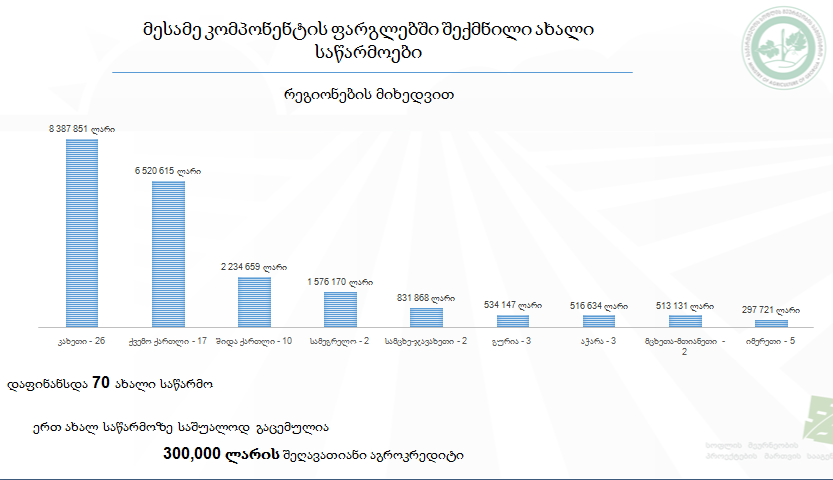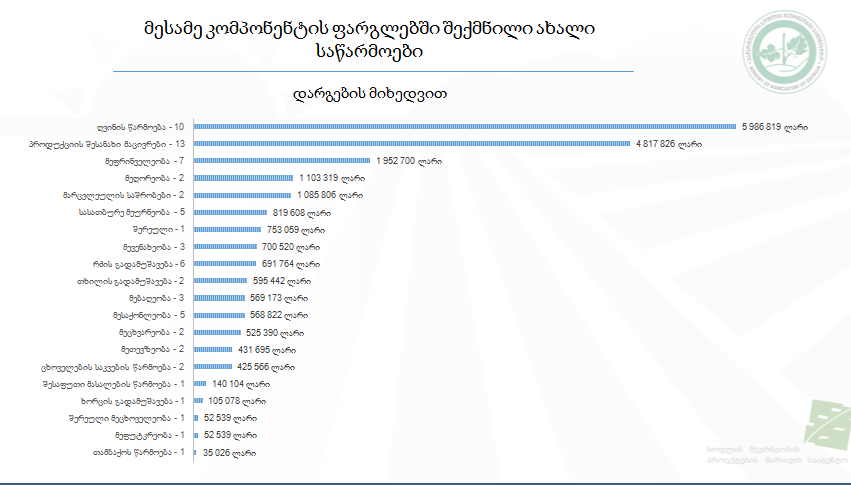On 15 January 2014, the Prime Minister of Georgia, Irakli Gharibashvili, held a press conference during which he discussed the economic affairs of Georgia. The PM stated: “Unfortunately, the economy we inherited had a negative trade balance of over 50% and a whole 80% of the basket of consumer goods and products of primary use depend upon import. The leading positions among exported products are predominantly held by goods of non-Georgian production. We received an economy where 54% of the employed are engaged in the agricultural sector and the share of agriculture in the country’s GDP does not exceed 9% while 11% are employed in the governmental sector. We have an import-oriented economy and, for years, its growth has been fuelled through the stimulation of consumption instead of production. This was made possible primarily by the means of the exported labour force. As a result of this process, we have received very high rates of unemployment.”
FactCheck inquired about the accuracy of the Prime Minister’s statement.
The external trade balance represents the difference between export and import. In the case if the difference has a negative value, the trade balance is considered to be negative as well. A negative balance in the external trade turnover exceeded 50% in the period from 2006 to 2012 whereas in 2013, it equalled 46%.

 FactCheck tried to establish what percentage of products included in the basket of consumer goods is imported to Georgia. We addressed this question to the National Statistics Office of Georgia and in line with the data received in response, of the 295 items of goods and services included in the basket, 108 (36.6%) are produced locally. A total of 78 items of goods and services (26.4%) are imported and the remaining 109 (37%) are of mixed production; that is, one part of them is produced domestically and another – imported from abroad.
As for export, the major fields of export are: automobiles (re-export), ferro-alloys, walnuts and hazelnuts, copper ores and concentrates, fertilisers, natural grape wines, mineral and fresh waters and alcoholic drinks. Medicines, trucks and wheat are also being re-exported in large volumes.
The small scale of the Georgian market is an influential factor for the development of domestic production. Additionally, the fact that in the given case goods of non-Georgian production are the most widely exported products of the country and Georgia rounds up a remarkable income from the re-export implies that the country takes good advantage of its geographic location of a transit country and this is far from being an unfavourable occurrence.
FactCheck tried to establish what percentage of products included in the basket of consumer goods is imported to Georgia. We addressed this question to the National Statistics Office of Georgia and in line with the data received in response, of the 295 items of goods and services included in the basket, 108 (36.6%) are produced locally. A total of 78 items of goods and services (26.4%) are imported and the remaining 109 (37%) are of mixed production; that is, one part of them is produced domestically and another – imported from abroad.
As for export, the major fields of export are: automobiles (re-export), ferro-alloys, walnuts and hazelnuts, copper ores and concentrates, fertilisers, natural grape wines, mineral and fresh waters and alcoholic drinks. Medicines, trucks and wheat are also being re-exported in large volumes.
The small scale of the Georgian market is an influential factor for the development of domestic production. Additionally, the fact that in the given case goods of non-Georgian production are the most widely exported products of the country and Georgia rounds up a remarkable income from the re-export implies that the country takes good advantage of its geographic location of a transit country and this is far from being an unfavourable occurrence.
 Employment rates of 2013 are yet to be published but in accordance with the data of 2012, the number of persons employed in the agricultural sector exceeds 909 thousand which amounts to 52.7% of the total employment in the country. In line with the data published by GeoStat, the share of agriculture in the GDP of 2012 equals 7.4% and according to the preliminary data of 2013 it totals 9.3%.
Employment rates of 2013 are yet to be published but in accordance with the data of 2012, the number of persons employed in the agricultural sector exceeds 909 thousand which amounts to 52.7% of the total employment in the country. In line with the data published by GeoStat, the share of agriculture in the GDP of 2012 equals 7.4% and according to the preliminary data of 2013 it totals 9.3%.
 In terms of employment in the governmental sector, we witness the following situation: in line with the data of 2012, the number of persons employed in this field exceeds 1,450 thousand and its share in the total employment amounts to 15.9%.
In terms of employment in the governmental sector, we witness the following situation: in line with the data of 2012, the number of persons employed in this field exceeds 1,450 thousand and its share in the total employment amounts to 15.9%.
 Conclusion
Throughout the years 2006-2012 the negative balance in Georgia’s foreign trade turnover went beyond 50% whereas in 2013 the indicator dropped to 46%.
In 2012 the number of persons employed in the field of agriculture amounted to 52.7% of the total number of employed whereas those employed in the governmental sector totalled 15.9%. In line with the preliminary data of 2013, the share of agriculture in Georgia’s GDP equalled 9.3%. These figures are essentially in agreement with the numbers indicated by the Prime Minister.
As gathered from the data provided by GeoStat, 36.6% of the products included in the basket of consumer goods are produced domestically, only 26.4% is imported and the remaining 37% is of a mixed nature. Therefore, this part of the Prime Minister’s statement is inaccurate.
The leading positions among exported goods of Georgia are held by the products manufactured locally (with the exception of the re-export of automobiles); namely, the export of walnuts and hazelnuts, ferro-alloys, mineral and freshwaters, fertilisers and natural grape wines. Although the largest field of Georgian export is the re-export of automobiles, this cannot be described as a negative occurrence. In the given case, this fact rather indicates that Georgia makes the most out of its potential as a transit country.
Consequently, we conclude that Irakli Gharibashvili’s statement, “Unfortunately, the economy we inherited had a negative trade balance of over 50%... A whole 80% of the basket of consumer goods and products of primary use depend upon import. The leading positions among exported products are predominantly held by goods of non-Georgian production… 54% of the employed are engaged in the agricultural sector and the share of agriculture in the country’s GDP does not exceed 9% while 11% are employed in the governmental sector,” is HALF TRUE.
Conclusion
Throughout the years 2006-2012 the negative balance in Georgia’s foreign trade turnover went beyond 50% whereas in 2013 the indicator dropped to 46%.
In 2012 the number of persons employed in the field of agriculture amounted to 52.7% of the total number of employed whereas those employed in the governmental sector totalled 15.9%. In line with the preliminary data of 2013, the share of agriculture in Georgia’s GDP equalled 9.3%. These figures are essentially in agreement with the numbers indicated by the Prime Minister.
As gathered from the data provided by GeoStat, 36.6% of the products included in the basket of consumer goods are produced domestically, only 26.4% is imported and the remaining 37% is of a mixed nature. Therefore, this part of the Prime Minister’s statement is inaccurate.
The leading positions among exported goods of Georgia are held by the products manufactured locally (with the exception of the re-export of automobiles); namely, the export of walnuts and hazelnuts, ferro-alloys, mineral and freshwaters, fertilisers and natural grape wines. Although the largest field of Georgian export is the re-export of automobiles, this cannot be described as a negative occurrence. In the given case, this fact rather indicates that Georgia makes the most out of its potential as a transit country.
Consequently, we conclude that Irakli Gharibashvili’s statement, “Unfortunately, the economy we inherited had a negative trade balance of over 50%... A whole 80% of the basket of consumer goods and products of primary use depend upon import. The leading positions among exported products are predominantly held by goods of non-Georgian production… 54% of the employed are engaged in the agricultural sector and the share of agriculture in the country’s GDP does not exceed 9% while 11% are employed in the governmental sector,” is HALF TRUE.

 FactCheck tried to establish what percentage of products included in the basket of consumer goods is imported to Georgia. We addressed this question to the National Statistics Office of Georgia and in line with the data received in response, of the 295 items of goods and services included in the basket, 108 (36.6%) are produced locally. A total of 78 items of goods and services (26.4%) are imported and the remaining 109 (37%) are of mixed production; that is, one part of them is produced domestically and another – imported from abroad.
As for export, the major fields of export are: automobiles (re-export), ferro-alloys, walnuts and hazelnuts, copper ores and concentrates, fertilisers, natural grape wines, mineral and fresh waters and alcoholic drinks. Medicines, trucks and wheat are also being re-exported in large volumes.
The small scale of the Georgian market is an influential factor for the development of domestic production. Additionally, the fact that in the given case goods of non-Georgian production are the most widely exported products of the country and Georgia rounds up a remarkable income from the re-export implies that the country takes good advantage of its geographic location of a transit country and this is far from being an unfavourable occurrence.
FactCheck tried to establish what percentage of products included in the basket of consumer goods is imported to Georgia. We addressed this question to the National Statistics Office of Georgia and in line with the data received in response, of the 295 items of goods and services included in the basket, 108 (36.6%) are produced locally. A total of 78 items of goods and services (26.4%) are imported and the remaining 109 (37%) are of mixed production; that is, one part of them is produced domestically and another – imported from abroad.
As for export, the major fields of export are: automobiles (re-export), ferro-alloys, walnuts and hazelnuts, copper ores and concentrates, fertilisers, natural grape wines, mineral and fresh waters and alcoholic drinks. Medicines, trucks and wheat are also being re-exported in large volumes.
The small scale of the Georgian market is an influential factor for the development of domestic production. Additionally, the fact that in the given case goods of non-Georgian production are the most widely exported products of the country and Georgia rounds up a remarkable income from the re-export implies that the country takes good advantage of its geographic location of a transit country and this is far from being an unfavourable occurrence.
 Employment rates of 2013 are yet to be published but in accordance with the data of 2012, the number of persons employed in the agricultural sector exceeds 909 thousand which amounts to 52.7% of the total employment in the country. In line with the data published by GeoStat, the share of agriculture in the GDP of 2012 equals 7.4% and according to the preliminary data of 2013 it totals 9.3%.
Employment rates of 2013 are yet to be published but in accordance with the data of 2012, the number of persons employed in the agricultural sector exceeds 909 thousand which amounts to 52.7% of the total employment in the country. In line with the data published by GeoStat, the share of agriculture in the GDP of 2012 equals 7.4% and according to the preliminary data of 2013 it totals 9.3%.
 In terms of employment in the governmental sector, we witness the following situation: in line with the data of 2012, the number of persons employed in this field exceeds 1,450 thousand and its share in the total employment amounts to 15.9%.
In terms of employment in the governmental sector, we witness the following situation: in line with the data of 2012, the number of persons employed in this field exceeds 1,450 thousand and its share in the total employment amounts to 15.9%.
 Conclusion
Throughout the years 2006-2012 the negative balance in Georgia’s foreign trade turnover went beyond 50% whereas in 2013 the indicator dropped to 46%.
In 2012 the number of persons employed in the field of agriculture amounted to 52.7% of the total number of employed whereas those employed in the governmental sector totalled 15.9%. In line with the preliminary data of 2013, the share of agriculture in Georgia’s GDP equalled 9.3%. These figures are essentially in agreement with the numbers indicated by the Prime Minister.
As gathered from the data provided by GeoStat, 36.6% of the products included in the basket of consumer goods are produced domestically, only 26.4% is imported and the remaining 37% is of a mixed nature. Therefore, this part of the Prime Minister’s statement is inaccurate.
The leading positions among exported goods of Georgia are held by the products manufactured locally (with the exception of the re-export of automobiles); namely, the export of walnuts and hazelnuts, ferro-alloys, mineral and freshwaters, fertilisers and natural grape wines. Although the largest field of Georgian export is the re-export of automobiles, this cannot be described as a negative occurrence. In the given case, this fact rather indicates that Georgia makes the most out of its potential as a transit country.
Consequently, we conclude that Irakli Gharibashvili’s statement, “Unfortunately, the economy we inherited had a negative trade balance of over 50%... A whole 80% of the basket of consumer goods and products of primary use depend upon import. The leading positions among exported products are predominantly held by goods of non-Georgian production… 54% of the employed are engaged in the agricultural sector and the share of agriculture in the country’s GDP does not exceed 9% while 11% are employed in the governmental sector,” is HALF TRUE.
Conclusion
Throughout the years 2006-2012 the negative balance in Georgia’s foreign trade turnover went beyond 50% whereas in 2013 the indicator dropped to 46%.
In 2012 the number of persons employed in the field of agriculture amounted to 52.7% of the total number of employed whereas those employed in the governmental sector totalled 15.9%. In line with the preliminary data of 2013, the share of agriculture in Georgia’s GDP equalled 9.3%. These figures are essentially in agreement with the numbers indicated by the Prime Minister.
As gathered from the data provided by GeoStat, 36.6% of the products included in the basket of consumer goods are produced domestically, only 26.4% is imported and the remaining 37% is of a mixed nature. Therefore, this part of the Prime Minister’s statement is inaccurate.
The leading positions among exported goods of Georgia are held by the products manufactured locally (with the exception of the re-export of automobiles); namely, the export of walnuts and hazelnuts, ferro-alloys, mineral and freshwaters, fertilisers and natural grape wines. Although the largest field of Georgian export is the re-export of automobiles, this cannot be described as a negative occurrence. In the given case, this fact rather indicates that Georgia makes the most out of its potential as a transit country.
Consequently, we conclude that Irakli Gharibashvili’s statement, “Unfortunately, the economy we inherited had a negative trade balance of over 50%... A whole 80% of the basket of consumer goods and products of primary use depend upon import. The leading positions among exported products are predominantly held by goods of non-Georgian production… 54% of the employed are engaged in the agricultural sector and the share of agriculture in the country’s GDP does not exceed 9% while 11% are employed in the governmental sector,” is HALF TRUE.
Originally published in The Financial, issue N. 17(397)








